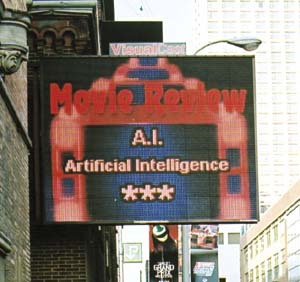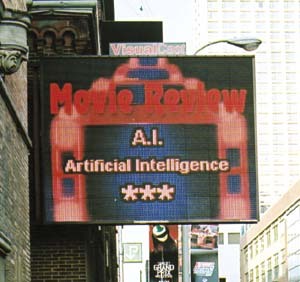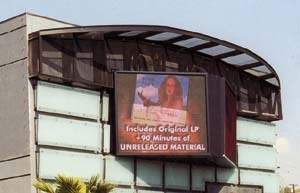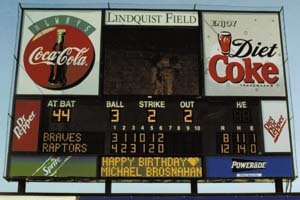Electric Signs
A Formula for Success
LED moving-message billboards must feature other elements beyond great technology to succeed
Published
18 years agoon

As long as there have been moving-message signs, businesses have been launched on the belief that other companies would buy ad space on those signs. A vast majority of those businesses have failed.
Armed with large-lamp, line-oriented behemoths, salespeople genuinely believed that moving messages attracted advertisers. With few exceptions, those beliefs were squashed because low-resolution, off-premise text messages simply didn’t provide advertising value.
With the advent of the full-matrix display, a new breed of hopefuls stepped forward and failed. With the advent of wedge-base lamp displays, which brought higher resolution and full color, yet another horde of confused and misguided animated-billboard marketers arose.
Today, you can’t blame technology for failure. High-resolution LED offers 16.7 million colors, true video proces-sing and enough brightness to com-mand attention in any environment.
Well, the jury is still out. A well-placed video screen, in the presence of a large audience, with the benefit of a willing sign ordinance, does not, in and of itself, spell success. The technology is less than five years old and, already, LED third-party advertising ventures have failed in Los Angeles, Las Vegas, New York City, Miami, Dallas and elsewhere.
Why? Because the success of a moving-message sign lies in more elements that just the technology. A highly visible video screen can be as successful as a high-powered radio station without employees. Creative juice, marketing skill and financial backing make a medium work. High-resolution image technology forms only one small part of the puzzle.
AdvertisementLos Angeles provides some excellent examples. The line of signs on Wilshire Blvd. includes a high-resolution video billboard. Although it possesses high-quality images and sufficient brightness, it’s a failing business venture.
Why? The display’s owner made serious mistakes in placement, size and advertising structure. The screen is placed on the back corner of a multi-level shopping center, well behind and above the normal line of sight. The image, although huge, lacks presence due to the viewing distance and height. Its advertising messages are short, silent, TV commercials.
I sat through a Cadillac commercial for nearly 10 seconds without dis-covering what product was promoted. Later, I saw the same commercial on television, where the voice-over made it a powerful piece. Without sound, it failed. Two essential components of success – good placement and ad creativity – are missing.
Up the hill on Sunset Blvd. sit three examples of LED video bill-boards. Two boards feature ineffect-ive technology with sad image quality. The other videoboard, which features high-quality images and proper placement, produces lively, entertaining images.
However, the advertising copy hasn’t been crafted for an outdoor video screen. Without sound, the ads are too long and confusing. I stopped my car directly in front of the board and watched it while taking notes for five minutes.
The board rotated four different ads — two movie promos, a local advertisement, and one — well, I still can’t determine what it was. None of the ads, without the benefit of sound, told the story of a product or service to be purchased, much less where or how to purchase it. Again, a very well-placed, extremely expensive videoboard lacked the proper formula for success.
AdvertisementWith so many initial LED ad failures, many so-called industry media watchers, smelling another generation of disappointment, bleat their call: "It just doesn’t work. Been tried, over and over, and it never has worked."
I concur that moving-message billboards have rarely worked. But the media concept, more often than not, has been handled improperly.
I remain convinced that it will work. It’s unfortunate that only a few have assembled a formula that makes sense, and they aren’t broadcasting that formula for the rest of us to plagiarize. Therefore, the business of third-party, motion-video advertising — video billboards — remains a fringe medium with a long way to go to find universal acceptance.
Yet, with the stakes higher than ever, the horde of willing media entrepreneurs grows exponentially. With the lure of a great location, a little media knowledge and available venture capital, new locations sprout every day. I’ve entertained calls from prospective ventures in Los Angeles, New York City, Chicago, New Orleans, Orlando, Dallas and Miami.
So what is this formula? Certainly, I profess no profound expertise in this area. However, I’ve spent a consider-able amount of time studying this phenomenon in hopes of finding the right mix. I’m happy to share what I’ve learned, hoping that others will do the same. Maybe with a little shared experience and insight, we can finally launch an effective new medium.
What doesn’t work
AdvertisementWe’ve seen that running an abbrev-iated television ad on an outdoor location is a formula for disaster. The success of TV advertising directly correlates to a self-captured audience. Take away sound and add the distraction of vehicular traffic, and you’ve found a true formula for failure.
Long ads, the modern version of a continually scrolling word message, are never read. First impressions are essential in advertising, and if the audience’s first view of the image is in the midst of a story line, the ad has already failed.
Short-duration (less than 20 seconds) video-display locations can’t succeed. Outdoor advertising in any form is valued incrementally on the amount of time the audience is exposed to the ad. Without the distance, you don’t have the time.
Improper format can kill the medium. A 14 x 48-ft. billboard works for static ads, but it dies with a motion display. Traditional video formats work better – 3 x 4 ft., 9 x 16 ft. and 9 x 32 ft. With those height-to-width ratios, traditional cameras and digital-formatting tools work.
Poor salesmanship spells death. We’re talking new media. Few understand it and fewer trust it. When a concept is presented to prospective advertisers, it requires a very professional, clearly explained, well-documented presentation.
Lack of a true validation method-ology will ward off agency players. Advertisers want confirmation that their ads ran, as prescribed, on the dates and times specified, without flaw. A printed validation statement, which depicts times, dates and length that each advertisement was shown, can be generated from most systems.
A poor product and faulty maintenance means instant failure. Factors include brightness, processing, contrast and myriad other factors. Most important, and perhaps most elusive, is product longevity. A great image at the time of installation must be effective far beyond that time. Advertising is a "what do you have for me today" scenario. If the screen technology loses brightness, color, clarity or periodically crashes, you lose.
What works
Crisp, clear customized ads in short duration are a mandate. The perfect ad runs for 10 seconds. It’s essential that advertising creators acknowledge the audience’s limitations. A moving audience is consistently distracted. Viewership can’t be constant. However, ads that show pertinent logos and products continually throughout the message succeed.
Because the audience may only view an image for a very few seconds, the ad still must encompass the essential outdoor adage, "The whole message in one shot." The ad must also be created with the same focus of any outdoor-advertising message, but with the added power of movement.
My favorite example, a McDonald’s ad, features a backyard with the "golden arches" on a red field. The copy reads, "It’s time for breakfast." Next to the copy is a cup of steaming coffee with an Egg McMuffin. Each time the ad appears, it shows a different menu selection. When a traveler first views the ad, he sees all of the basic elements of the message. Yet, unlike a static ad, it’s alive with movement. That movement helps draw the message out of the roadside clutter.
A cellular company in Toronto used a videoboard to demonstrate new phones sporting a wide range of colors. The entire message idea was visible at all times on the board, but the phones were animated and continually changed color.
As nearly as I can tell, the formula for success looks like this: Consistent, high-quality image + technical expertise + creative talent + media savvy + ad-agency relationships + professional salesmanship + a high-traffic location + proper permitting + media verification + a lot of money = success.
Are there any successes?
In Ontario, success flourishes. A small company called Hi There Media has placed several quality videoboards in Niagara Falls, Hamilton and Toronto, and has marketed them well. Hi There’s Nigel Osborne indicated several national clients.
Osborne noted that the ads’ success lies in the detail and time spent in creating an ad for a particular location, as well as a particular time of day. This company measures the available read time of each location at different times of the day and tailors the ad to fit that particular audience. I know of no other company in the industry with that finite approach.
Tribar Industries (Downsview, Ontario, Canada) has placed several boards in the greater Toronto area, where unique animated advertising has been the norm for decades.
In Nevada and California, Alaris Media (Las Vegas and Sacramento, CA), formerly EXCN, struggled and experimented with LED advertising screens since its inception. The company now embraces new agency relationships, which may prove a boon to sales and creative, as well as spell success for the new medium.
In Vancouver, British Columbia, LightVision, a small company with a single-location, third-party, advertising board, is thriving.
South America also claims numerous LED advertising-board successes. Brazil alone has many installations, most of them quite profitable, running a mixture of local, national and international ads.
The medium will work
Virtually everyone who knows media understands that the success of moving-message billboards is inevitable. The medium will work. The fact that it has rarely worked previously is no measure of future potential.
The medium is new, unqualified and not properly packaged. But dooming it in its infancy is akin to the horseman who shook his head with disgust as he passed a broken-down motorcar in the late 1800s.
The right technology now exists. And the application of that tech-nology will unfold over the next few years. It will be a fascinating story to watch as the very concept of outdoor advertising changes before our eyes.

SPONSORED VIDEO
Introducing the Sign Industry Podcast
The Sign Industry Podcast is a platform for every sign person out there — from the old-timers who bent neon and hand-lettered boats to those venturing into new technologies — we want to get their stories out for everyone to hear. Come join us and listen to stories, learn tricks or techniques, and get insights of what’s to come. We are the world’s second oldest profession. The folks who started the world’s oldest profession needed a sign.
You may like

Orbus Celebrates Earth Day With Recycling Achievements

American Sign Museum Names New Executive Director

3 Things Print Pros Must Do to Build Stronger Relationships in the Interiors Market
Subscribe

Bulletins
Get the most important news and business ideas from Signs of the Times magazine's news bulletin.
Most Popular
-

 Tip Sheet1 week ago
Tip Sheet1 week agoAlways Brand Yourself and Wear Fewer Hats — Two of April’s Sign Tips
-

 Photo Gallery2 days ago
Photo Gallery2 days ago30 Snapshots of the 2024 ISA Sign Expo
-

 Ask Signs of the Times4 days ago
Ask Signs of the Times4 days agoWhy Are Signs from Canva so Overloaded and Similar?
-

 Real Deal1 week ago
Real Deal1 week agoA Woman Sign Company Owner Confronts a Sexist Wholesaler
-

 Benchmarks6 days ago
Benchmarks6 days ago6 Sports Venue Signs Deserving a Standing Ovation
-

 Women in Signs1 week ago
Women in Signs1 week ago2024 Women in Signs: Megan Bradley
-

 Photo Gallery1 week ago
Photo Gallery1 week ago21 Larry Albright Plasma Globes, Crackle Tubes and More
-

 Women in Signs1 week ago
Women in Signs1 week ago2024 Women in Signs: Ashley Borell














